Related Research Articles

The northern region of Europe has several definitions. A restrictive definition may describe Northern Europe as being roughly north of the southern coast of the Baltic Sea, which is about 54°N, or may be based on other geographical factors such as climate and ecology.
A Flora is a book or other work which describes the plant species occurring in an area or time period, often with the aim of allowing identification. The term is usually capitalized to distinguish it from the use of "flora" to mean the plants rather than their descriptions. Some classic and modern Floras are listed below.

The small dusty wave is a moth of the family Geometridae first described by Franz von Paula Schrank in 1802. It is found throughout Western, Central and Northern Europe. In the north, its range extends as far as Denmark and southern Scandinavia. In the east its range extends as far as Russia. Idaea seriata is replaced by the subspecies Idaea seriata canteneraria, from the north-east of Spain and the central and eastern Mediterranean to the Crimean peninsula, while the western Mediterranean and the Balearic Islands are inhabited by the sister species Idaea minuscularia. Outside Europe it is found in eastern Algeria, Tunisia, Turkey, Cyprus, the Caucasus and the northwest of Transcaucasia. In Morocco and western Algeria, it is replaced by the sister species Idaea minuscularia. In the British Isles it is common in England and Wales but is only found in the eastern half of Scotland and it is rare in Ireland.

The purple thorn is a moth of the family Geometridae. The species was first described by Johann Siegfried Hufnagel in 1767. It is a species of both Northern Europe and Central Europe. It has a scattered distribution in Britain but is absent from Ireland.

Gyraulus crista, commonly called the Nautilus ramshorn, is a minute species of freshwater snail, an aquatic pulmonate gastropod mollusk in the family Planorbidae, the ram's horn snails.

Gyraulus laevis is a small species of freshwater snail, an aquatic pulmonate gastropod mollusc in the family Planorbidae, the ram's horn snails.
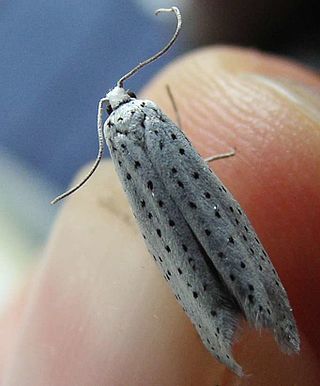
Yponomeutinae is a subfamily of "micromoths" in the lepidopteran family Yponomeutidae. As their scientific name implies, this is the subfamily containing the type genus of the ermine moths, Yponomeuta. The subfamily has worldwide distribution.

The fauna of Ireland comprises all the animal species inhabiting the island of Ireland and its surrounding waters.

Euplagia quadripunctaria, the Jersey Tiger, or Spanish Flag, is a diurnal moth of the family Erebidae. The species was first described by Nikolaus Poda von Neuhaus in 1761. The adult wingspan is 52–65 millimetres (2.0–2.6 in), and they fly from July to September, depending on the location. They tend to fly close to Eupatorium cannabinum.

Testacella maugei is a species of air-breathing, carnivorous land slug, a terrestrial gastropod mollusc in the family Testacellidae, the shelled slugs.

Notiophilus biguttatus is a species of ground beetle native to the Palearctic. It was first described by Johan Christian Fabricius in 1779. Sometimes referred to as the Common springtail stalker
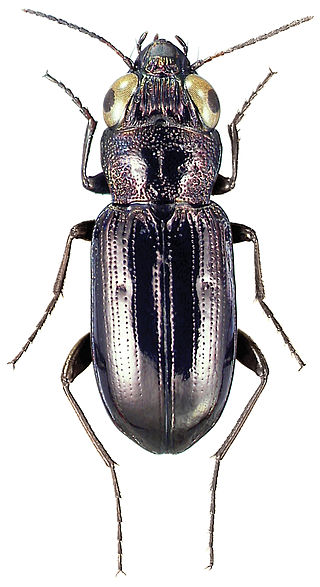
Notiophilus aquaticus is a species of ground beetle native to the Palearctic and the Nearctic. In Europe, it is found in Andorra, Austria, Belarus, Belgium, Bosnia and Herzegovina, Great Britain including the Isle of Man, Bulgaria, Croatia, the Czech Republic, mainland Denmark, Estonia, the Faroe Islands, Finland, mainland France, Germany, Iceland, the Republic of Ireland.
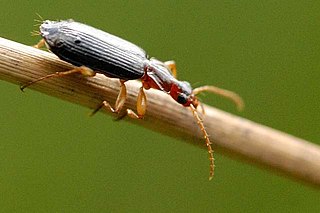
Dromius agilis is a species of ground beetle endemic to the Palearctic. In Europe, it is found in Austria, the Balearic Islands (doubtful), Belarus, Belgium, Bosnia and Herzegovina, Bulgaria, Croatia, the Czech Republic, mainland Denmark, Estonia, Finland, mainland France, Germany, Great Britain including the Isle of Man, mainland Greece, Hungary, the Republic of Ireland, mainland Italy, Kaliningrad, Latvia, Liechtenstein, Lithuania, Luxembourg, Moldova, Northern Ireland, North Macedonia, mainland Norway, Poland, Russia, Slovakia, Slovenia, mainland Spain, Sweden, Switzerland, the Netherlands, Ukraine, and Yugoslavia.

Hydroporus erythrocephalus is a species of water beetle native to the Palearctic and the Near East. In Europe, it is found in Austria, Belarus, Belgium, Bosnia and Herzegovina, Bulgaria, the Channel Islands, Corsica, Croatia, the Czech Republic, mainland Denmark, Estonia, the Faroe Islands, Finland, mainland France, Germany, Great Britain including the Isle of Man, Hungary, the Republic of Ireland, mainland Italy, Kaliningrad, Latvia, Lithuania, Luxembourg, Northern Ireland, mainland Norway, Poland, Russia except in the South, Slovakia, Slovenia, Sweden, Switzerland, the Netherlands, Ukraine.
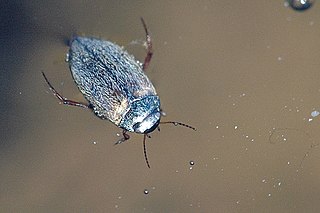
Hydroporus pubescens is a species of water beetle native to the Palearctic and the Near East. In Europe, it is only found in Albania, Austria, the Balearic Islands, Belgium, Bosnia and Herzegovina, Bulgaria, the Channel Islands, Corsica, Crete, Croatia, Cyprus, the Czech Republic, mainland Denmark, the Dodecanese, Estonia, European Turkey, the Faroe Islands, Finland, mainland France, Germany, Great Britain including the Isle of Man, mainland Greece, the Republic of Ireland, mainland Italy, Kaliningrad, Latvia, Luxembourg, Northern Ireland, North Macedonia, mainland Norway, Poland, mainland Portugal, Russia, Sardinia, Sicily, Slovakia, Slovenia, mainland Spain, Sweden, Switzerland, the Netherlands, Ukraine and Yugoslavia.

Colymbetes fuscus is a species of beetle native to the Palearctic, including Europe, the Near East and North Africa. In Europe, it is only found in Austria, the Balearic Islands, Belarus, Belgium, Bosnia and Herzegovina, Great Britain including Shetland, Orkney, Hebrides and Isle of Man, Bulgaria, the Channel Islands, Corsica, Croatia, Cyprus, the Czech Republic, mainland Denmark, Estonia, European Turkey, Finland, mainland France, Germany, mainland Greece, Hungary, the Republic of Ireland, mainland Italy, Kaliningrad, Latvia, Liechtenstein, Lithuania, Luxembourg, Malta, Northern Ireland, North Macedonia, mainland Norway, Poland, mainland Portugal, Russia except in the North, Sardinia, Sicily, Slovakia, Slovenia, mainland Spain, Sweden, Switzerland, the Netherlands, Ukraine and Yugoslavia.

Ilybius ater is a species of beetle native to the Palearctic, including Europe, and the Near East.

Hadena caesia, also called the grey, is a species of moth of the family Noctuidae. It has a scattered distribution all over Europe.
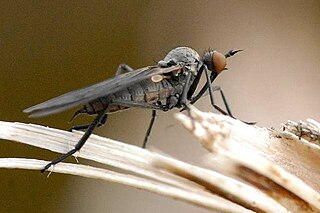
Rhamphomyia albidiventris is a species of dance flies, in the fly family Empididae. It is included in the subgenus Pararhamphomyia. It has a limited distribution. It has been recorded from Great Britain, Germany, Austria, Slovakia, Bosnia, Finland and central Russia.

Around 65 species of crab occur in the waters of the British Isles. All are marine, with the exception of the introduced Chinese mitten crab, Eriocheir sinensis, which occurs in fresh and brackish water. They range in size from the deep-water species Paromola cuvieri, which can reach a claw span of 1.2 metres, to the pea crab, which is only 4 mm (0.16 in) wide and lives inside mussel shells.